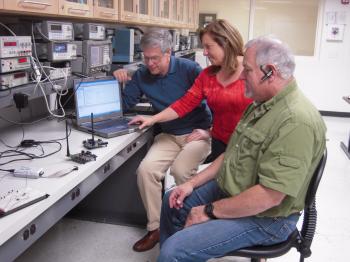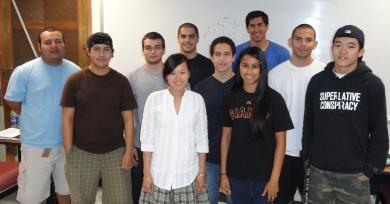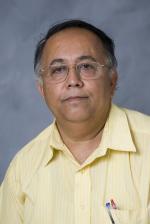Project-based experiences expand learning, career opportunities for students and faculty
Learning the theory behind practice is an essential part of education. But knowing how to apply that theory can make the difference between a freshly minted engineer who can get right down to business in a new job and one who has a steeper learning curve. It can also be a decisive factor in getting hired. That’s why hands-on projects are a major part of a CECS education, whether as class assignments or generated in partnership with industry or government agencies.
Several recent design and research projects in the college have provided unique collaborative opportunities for CECS students, working in concert with faculty and/or industry professionals.
Pratt & Whitney Rocketdyne
A large design clinic project at Pratt & Whitney Rocketdyne is engaging five students—two graduate, three undergraduate—in paid internships relating to rocket engines through the college’s Honors Co-Op program (see p. 18). Two students are involved in testing, another in electronic design and two in business aspects of the company. In a first for the Honors Co-Op, which heretofore has been limited to engineering and computer science students, these last two students hail from the College of Business and Economics, and their participation was requested by Pratt & Whitney Rocketdyne. The projects run from June to December, with student presentations in November.
“Usually Honors Co-Op projects last a year,” explains Bruno Osorno, the CECS professor of electrical and computer engineering who directs the program. “This is first one where the timeframe was switched to accommodate the company. The ultimate winners are the students who get the experience.”
NAVAIR Design Clinic project
 From left, professors James Flynn, Sharlene Katz, and David Schwartz
From left, professors James Flynn, Sharlene Katz, and David Schwartz
For several years, Sharlene Katz, James Flynn, and David Schwartz, professors of electrical and computer engineering, have been working on software-defined radio, a relatively new technology that promises to improve the performance of military communications systems (see Spectra, Spring 2010). CECS design clinic projects in software-defined radio for Edwards Air Force Base attracted the attention of the Naval Air Weapons Center Weapons Division (NAWCWD), and as a result, for the past two years, Katz, Flynn, Schwartz and three CECS graduate students a year have been working on projects relating to communications and software-defined radio for NAWCWD as well. The graduate students are working on the projects as a culminating experience.
NSF STEPS
 NSF STEPS students. Front row: Bryan Sanchez, Annie Norn, Sylvia Dhimdis, Jaesoon Lee; middle row: Arnold Martinez, Dragos Guta, Kenneth Moreno, Matthew Ferrer; back row: Vardo Barsegyan, Lorenzo Rulli
NSF STEPS students. Front row: Bryan Sanchez, Annie Norn, Sylvia Dhimdis, Jaesoon Lee; middle row: Arnold Martinez, Dragos Guta, Kenneth Moreno, Matthew Ferrer; back row: Vardo Barsegyan, Lorenzo Rulli
CSUN’s NSF-funded Students Targeting Engineering and Physical Science (STEPS) grant provided lower-division students with two opportunities to take part in research projects last summer. The first, directed by Bruno Osorno, with support from two faculty members from the urban planning department in the College of Social and Behavioral Sciences, was to design, build and test an electric bicycle. Nine students, working in two teams, learned the many variables that needed to be taken into consideration, such as selecting a battery to provide optimum range and avoid the environmental consequences of having to change cheaper ones more often. They also learned how to design a bike so that a rider could pedal or use downhills to generate electricity when the battery ran out. The project dovetailed with CSUN’s effort to develop its own bicycle system with a connection to a future Metropolitan Transit System hub on campus.
In a project with special resonance at CSUN, Sharlene Katz and James Flynn led two groups of five students in building a seismometer capable of recording distant quakes as well as the small, local quakes that occur almost every day.
“It’s fairly simple to build one,” Katz says, “but it takes a huge amount of math and physics to understand how it works.”
The seismometer they built was like a single node on a larger early warning system, similar to the network that exists in Japan. When there is an earthquake, the system broadcasts a message, saying, essentially, “Take cover!” It measures the quake, knows how fast waves travel and can send that information at a moment’s notice, providing about 45 seconds’ warning. “It isn’t long,” Katz says, “but people can take cover. And if a doctor is doing surgery, for instance, it’s enough time to stop before cutting.”
In addition to the seismometer itself, the students developed a software interface so the instrument could communicate with a computer and send an e-mail alert as part of a larger system of nodes.
All participants received a $1,000 stipend and a priority registration, which is a powerful incentive. “They were very motivated,” Osorno says, “plus they have the experience of doing something they might enjoy.”
Department of Defense Army Research Office
Somnath Chattopadhyay
 As any air traveler knows, when an airplane takes off, passengers are required to turn off their electronic devices. The reason is that these devices can potentially interfere with the power systems in the plane. If Somnath Chattopadhyay, a lecturer in electrical and computer engineering, is successful with his research, however, such interference may someday be a thing of the past. Chattopadhyay is the principal investigator on a grant from the Department of Defense’s Army Research Office to develop an optically controlled silicon carbide/gallium nitride–based MESFET (metal semiconductor field effect transistor), which will control the actuators in an airplane’s onboard power system with UV light rather than electrically, so it won’t be disrupted by radiofrequency or electromagnetic fields.
As any air traveler knows, when an airplane takes off, passengers are required to turn off their electronic devices. The reason is that these devices can potentially interfere with the power systems in the plane. If Somnath Chattopadhyay, a lecturer in electrical and computer engineering, is successful with his research, however, such interference may someday be a thing of the past. Chattopadhyay is the principal investigator on a grant from the Department of Defense’s Army Research Office to develop an optically controlled silicon carbide/gallium nitride–based MESFET (metal semiconductor field effect transistor), which will control the actuators in an airplane’s onboard power system with UV light rather than electrically, so it won’t be disrupted by radiofrequency or electromagnetic fields.
“This is a completely new technology, which will have no interference from the electromagnetic field,” Chattopadhyay says.
In addition to being impervious to electromagnetic interference, the technology has other advantages. It will potentially lighten aircraft by 30%, and it will not be vulnerable to radiation at high altitudes, or to heat and cold, which can also interfere with signals.
Students will play a key role in the three-year project. He worked with two undergraduates over the summer and plans to hire a graduate student in year one and two graduate and two undergraduate students in years two and three of the grant.
Chattopadhyay expects that the device will be completed in 2½ years. At that point, he will give it to Boeing, the end user, for testing in aircraft.
A Message from the Dean (SPECTRA 2013 VERSION)
November 30, 2012CSUN expanding presence in assistive technology
November 30, 2012
Leave a reply Cancel reply
-
Alumni Spotlight
February 6, 2014 -
Design Clinics: Antenna Measurement Lab: Computer-aided processing
February 6, 2014
